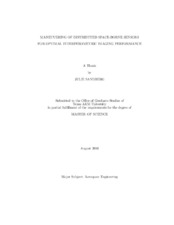| dc.description.abstract | The need for high resolution, continuously sustained imaging drives the interest
in space-borne, distributed aperture, interferometric (amplitude, heterodyne, or
intensity correlation) systems. This paper will discuss the maneuver controls for a
system of multiple space-based telescopes to secure optimal image quality. Such distributed
aperture systems eff ectively measure the Fourier Transform of the collected
light so that the observed wave pattern is seen in the frequency plane. This Fourier
Transform representation of physical spacecraft maneuvers may be interpreted as
coverage regions (discs) in the frequency plane. Superior coverage of the frequency
plane, which is directly related to image quality, is investigated for imaging distant
objects using interferometric techniques where apertures are distributed on multiple
space-based telescopes. The corresponding cost function is based on the optimality of
the spacecraft maneuvers, which in turn is based on achieving a high image quality.
This study builds on previous research wherein the first-order necessary conditions
(FONC) were derived. The FONC are derived for specialized rectilinear motion
and expanded to incorporate varying coverage disc velocities. These linearized equations
are verifi ed to be consistent with those for the constant velocity case. Next,
linearized first-order necessary conditions are shown to correspond closely with the
fully nonlinear case. After that, the conditions for optimal overlap of the coverage
paths will be given; these conditions lead to the optimal cost based on frequency plane
parameters. Finally, a heuristic approach will be used to compare diff erent frequency plane coverage strategies. An analogy to painting will be presented to demonstrate
adequate signal-to-noise ratio required for a desired image quality. | en |


